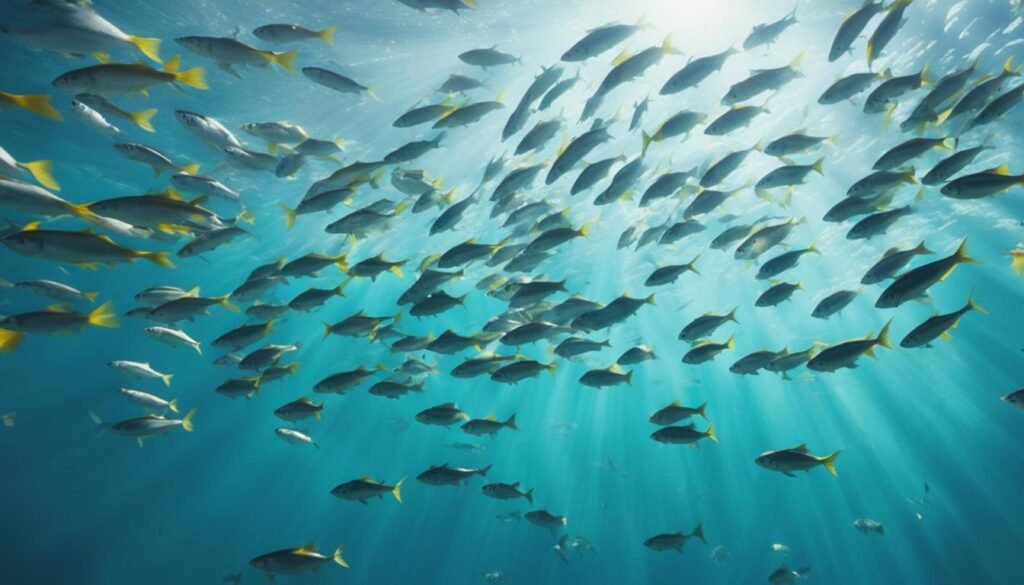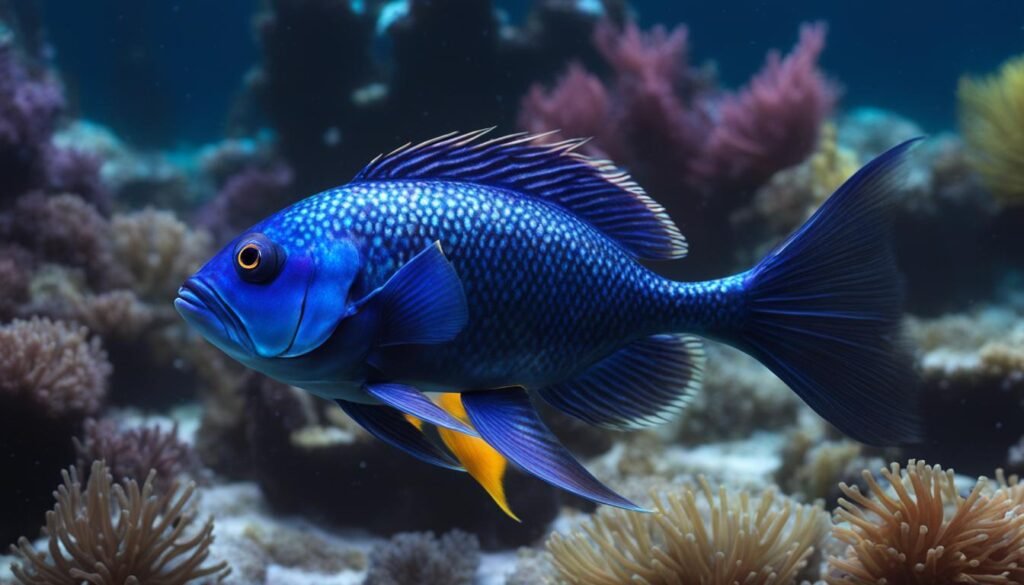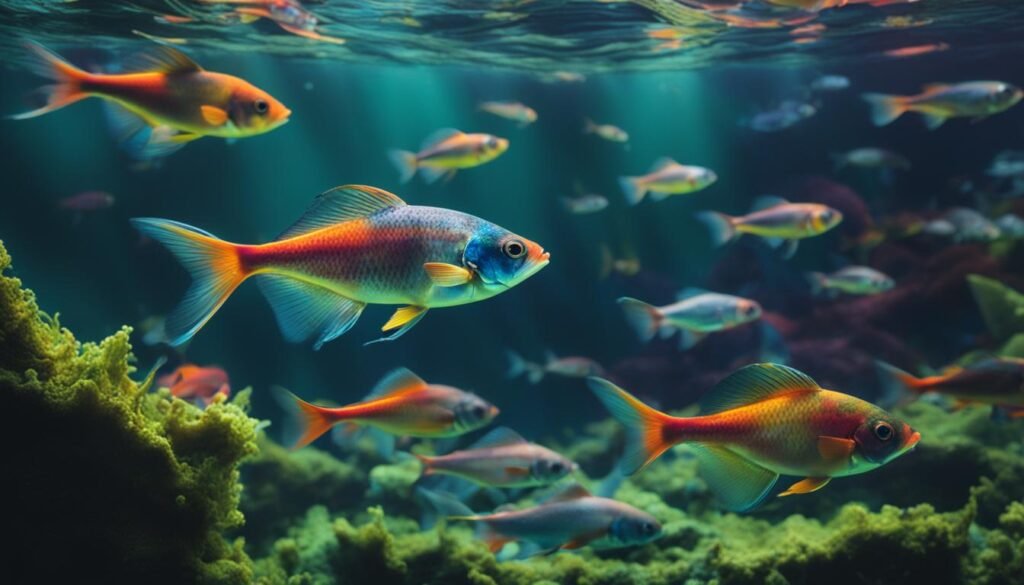Table of Contents
Welcome to our exploration into the fascinating world of fish vision! Have you ever wondered how fish perceive the water they swim in? In this article, we will uncover the secrets behind their ability to see in water and unveil the complex mechanisms that enable them to navigate through their aquatic habitat.
As you dive into this captivating topic, you’ll gain a deeper understanding of fish behavior, adaptations, and how they interact with their environment. So, let’s take a closer look and unravel the mysteries of fish vision!
Key Takeaways:
- Fish vision is a fascinating area of study that explores how these aquatic creatures perceive their environment and navigate through the water.
- Understanding fish vision provides insights into their behavior, adaptations, and interactions with their aquatic habitat.
- Fish eyes have unique structures and mechanisms adapted to their underwater environment.
- Light absorption, adaptations for light and dark conditions, and color perception play vital roles in fish visibility underwater.
- Technological advancements such as HD underwater cameras have revolutionized the study of fish vision.
Exploring the Aquatic Eye: How Fish Perceive Their Environment
Fish have unique eyes that are adapted to their underwater environment. Unlike terrestrial animals, their eyes have different structures and mechanisms that enable them to navigate and thrive in water. Fish heavily rely on visual cues to find their way, locate food, and detect potential predators.
This section will delve into the anatomy and functions of fish eyes, shedding light on how these fascinating creatures perceive their underwater environment.
Can fish see water and The Complexities of Underwater Vision
Anatomy of Fish Eyes and Vision Mechanisms
Fish eyes have unique structures that allow them to see in water. Their eyes consist of different components, including the cornea, lens, retina, and photoreceptor cells (rods and cones). Each component plays a vital role in the fish’s vision and ability to perceive their surroundings. Understanding the anatomy of fish eyes helps us comprehend how they see water.
Adaptations for Light and Dark: Fish Vision Across Depths
Fish have remarkable adaptations that enable them to see in both light and dark environments throughout different depths of water. In shallow, sunlit areas, their eyes have specialized structures to navigate bright conditions and make the most of available light. In deeper waters where light diminishes, fish have developed additional visual adaptations to detect and recognize objects in low-light settings. Their vision mechanisms vary across species, ensuring they can thrive in diverse aquatic habitats.
Color Perception and Clarity in Aquatic Habitats
Color perception in aquatic habitats is a fascinating aspect of fish vision. While the visibility of colors depends on water clarity, the ability to perceive and distinguish colors provides valuable information about the environment, predators, and potential prey. Fish have color-sensitive cells called cones that allow them to perceive a range of colors, although their color vision may differ from that of humans. Understanding color perception in aquatic habitats provides insights into the visual cues fish rely on for survival and communication.

| Fish Vision Adaptations | Light Environment | Dark Environment |
|---|---|---|
| Eye Structures | Optimized for bright conditions, with adaptations to protect against excessive light and enhance visual acuity. | Enhanced sensitivity to low light, larger pupils, and specialized cells for detecting bioluminescence. |
| Color Perception | Ability to perceive a wide range of colors, crucial for identifying food, mates, and predators. | Reduced color discrimination in favor of detecting contrasting shades and movement. |
| Vision Range | Able to see in a wide range of light intensities, leveraging available sunlight for navigation. | Utilize bioluminescence and other low-light adaptations for survival and communication. |
The Role of Light Absorption in Fish Visibility
Light plays a crucial role in the visibility of fish underwater. The ability to see clearly is essential for fish to navigate their environment, find food, and avoid predators. However, water significantly affects the transmission of light, as it absorbs and scatters light particles.
Water absorbs different colors of light to varying degrees, depending on their wavelength. Longer wavelengths, such as red and orange, are absorbed more quickly, while shorter wavelengths, such as blue and violet, penetrate deeper into the water. This results in a gradual decrease in light intensity as depth increases.
Fish have evolved to adapt to the specific light conditions of their habitats, allowing them to optimize their visibility. Different species of fish have different visual adaptations to compensate for the changes in light absorption underwater. Some species have larger eyes, specialized lenses, or increased rod and cone density to enhance their ability to see in varying light conditions.
By understanding the role of light absorption in fish visibility, researchers and conservationists can gain insights into the behavior, ecology, and conservation needs of different fish species. It also emphasizes the importance of protecting the water quality and clarity, as it directly impacts the visibility of fish and their overall survival.
| Water Depth | Color Absorption |
|---|---|
| Surface | Red, Orange |
| Mid-depth | Yellow, Green |
| Deep | Blue, Violet |
Visual Adaptations: Evolutionary Developments in Fish Sight
Bioluminescence and the Deep-Sea Vision
Deep-sea fish inhabit extreme environments where sunlight cannot penetrate. In the depths of the ocean, these remarkable creatures have developed unique adaptations to survive and thrive. One such adaptation is bioluminescence, the ability to produce light. Bioluminescent fish are equipped with specialized organs called photophores that emit light, allowing them to navigate and communicate in the darkness.
Bioluminescence in deep-sea fish serves multiple purposes. It helps them attract prey by luring smaller organisms towards their light, acting as a visual bait. It also aids in camouflage, as some bioluminescent fish can control the intensity and pattern of their light production, allowing them to blend into their surroundings or mimic the patterns of sunlight filtering through the water’s surface.
Moreover, bioluminescence enables deep-sea fish to communicate with each other. They use light signals to attract mates, warn off potential predators, or communicate within their social groups, creating a mesmerizing light show in the otherwise pitch-black depths.
By studying the visual adaptations of deep-sea fish, scientists can gain insights into the complexities of underwater vision and the incredible range of strategies that fish have evolved to survive in extreme environments.
Navigating Murky Waters: Insights from TrueColor Technology
In murky waters, fish face the challenge of limited visibility due to suspended particles, sediment, and low light conditions. However, advancements in technology have provided a way to overcome these obstacles and understand how fish perceive their environment even in the most challenging conditions.
TrueColor technology, pioneered by Aqua-Vu, utilizes specialized imaging systems to capture and reproduce underwater scenes with unparalleled clarity and color accuracy. This innovation allows researchers to study fish vision in murky waters and observe the visual adaptations that enable fish to navigate and interact within their habitats.
By utilizing TrueColor technology, scientists can gain valuable insights into the visual adaptations of fish that inhabit murky waters. They can uncover how these adaptations enhance their ability to detect prey, avoid predators, and navigate in environments with limited visibility.
This technology also plays a crucial role in conservation efforts, as it allows researchers to understand the impact of environmental changes on fish vision and develop strategies to protect these unique and fragile ecosystems.

| Bioluminescence in Deep-sea Fish | TrueColor Technology Benefits |
|---|---|
| Allows fish to navigate and communicate in the darkness | Enables study of visual adaptations in murky waters |
| Serves as a visual bait to attract prey | Reproduces underwater scenes with unparalleled clarity |
| Aids in camouflage and mimicry | Provides insights into fish vision in low light conditions |
| Facilitates communication within social groups | Contributes to conservation efforts and ecosystem protection |
Do Fish Need Light to Navigate the Night?
Fish, like many other creatures, have adapted to thrive in a variety of environments, including the darkness of the night. Despite the limited availability of light, fish possess remarkable night vision capabilities that allow them to navigate and hunt in low-light conditions. Understanding how fish see in the dark sheds light on their fascinating adaptations and survival strategies.
Understanding Fish Night Vision Capabilities
Fish night vision is made possible by specialized adaptations that enhance their ability to see in low-light environments. These adaptations include:
- Large eyes: Fish often have larger eyes compared to their body size, allowing them to gather more available light.
- Tapetum lucidum: Some fish have a reflective layer called the tapetum lucidum behind their retina, which helps to amplify the available light and enhance their vision.
- Enhanced rod cells: Rod cells in the fish’s eyes are responsible for detecting light and motion. Fish have a higher density of rod cells, which are more sensitive to light, enabling them to see in dimly lit conditions.
These adaptations collectively contribute to their ability to navigate and identify objects even in the darkest depths of the water.
Artificial Light vs. Natural Light: Benefits for Aquatic Life
The presence of both natural and artificial light sources in aquatic environments can have significant benefits for fish and other aquatic life. Let’s explore the advantages of each:
Natural Light:
- Regulates circadian rhythms: Natural light helps govern the biological rhythms of fish, influencing their behavior, feeding, and reproduction patterns.
- Promotes growth and development: Adequate exposure to natural light plays a vital role in the growth and development of fish, ensuring healthy bone structure and overall well-being.
- Provides camouflage: Natural light, such as sunlight filtering from the water’s surface, helps fish blend into their surroundings, providing a protective camouflage against predators and enhancing their hunting success.
Artificial Light:
- Enhances visibility: Artificial light sources, such as underwater lamps or fishing boat lights, can improve visibility for fish, aiding their navigation and foraging activities.
- Promotes feeding behavior: Artificial light can attract prey organisms, increasing the likelihood of successful feeding for fish.
- Facilitates research and observation: Scientists and researchers use artificial light sources to study fish behavior, migration patterns, and habitat preferences, contributing to our understanding of aquatic ecosystems.
Both natural and artificial light play vital roles in the lives of fish and other aquatic organisms, providing essential cues and facilitating their survival in the underwater world.

The Impact of Environmental Factors on Fish Vision: Understanding the Interplay
| Environmental Factor | Impact on Fish Vision |
|---|---|
| Water Clarity | Affects visibility and the ability to locate food and avoid predators. Clear water allows for better light penetration, while murky water reduces visibility. |
| Temperature | Extreme temperatures can disrupt the functioning of fish visual systems, impairing their ability to detect prey, spot predators, and find suitable mates. |
| Pollution | Toxins and pollutants in the water can accumulate in fish tissues, affecting their visual receptors and impairing their ability to perceive their surroundings accurately. |
Technological Advancements in Observing Fish Vision
With the rapid advancements in technology, our understanding of fish vision has been greatly enhanced. One remarkable breakthrough in this field is the development of HD underwater cameras, which have completely revolutionized our ability to observe fish behavior and explore underwater ecosystems.
HD underwater cameras provide us with high-quality footage and detailed insights into fish vision and their interactions within their aquatic habitats. These cameras offer exceptional clarity and resolution, allowing us to capture even the most intricate details of fish behavior and their visual perception of the underwater world.
Whether it’s studying the fascinating adaptations of deep-sea fish or unraveling the mysteries of color perception in aquatic habitats, HD underwater cameras have proven to be invaluable tools for researchers and scientists. They enable us to document and analyze fish behavior in unprecedented detail, leading to new discoveries and a better understanding of the complexities of fish vision.
The Breakthroughs of HD Underwater Cameras
HD underwater cameras boast several groundbreaking features that have significantly improved our ability to study fish vision. These features include:
- High-resolution imagery: HD cameras capture footage in stunning detail, allowing us to closely examine the visual capabilities of fish and their interactions with their environment.
- Advanced imaging technology: These cameras employ cutting-edge imaging technology that enhances image quality, making it easier to observe subtle visual cues and behaviors.
- Underwater durability: HD underwater cameras are specifically designed to withstand the challenging underwater conditions, ensuring reliable and high-quality footage even in harsh environments.
- Portable and versatile design: These cameras are lightweight and compact, making them easy to carry and deploy in various underwater settings, including reefs, deep-sea environments, and freshwater habitats.
The combination of these breakthrough features allows researchers to capture and analyze visual data in ways that were previously unimaginable. HD underwater cameras have unlocked a new level of understanding when it comes to fish vision and the intricacies of their underwater world.
How Aqua-Vu’s TrueColor Illuminates Underwater Mysteries
One notable player in the realm of underwater cameras is Aqua-Vu, a leading brand that has introduced groundbreaking technology to the field. Aqua-Vu’s TrueColor technology sets a new standard for underwater imaging by accurately capturing the colors and details of fish vision.
TrueColor technology surpasses traditional camera systems by accurately replicating the colors and visual spectrum of the underwater environment. This advancement allows researchers to gain a deeper understanding of how fish perceive colors and distinguish objects in their surroundings.
By utilizing Aqua-Vu’s TrueColor technology, scientists can unravel the mysteries of underwater ecosystems and gain critical insights into fish vision. Whether it’s exploring the impact of environmental factors on visual perception or studying the behavior of elusive fish species, TrueColor technology provides a valuable tool for researchers in their quest to understand and protect aquatic life.
Conclusion
Fish vision is a captivating subject that offers valuable insights into the remarkable adaptations and abilities of these aquatic creatures. By understanding how fish see water and navigate their environment, we can make significant strides in conservation efforts, enhance fish health in captivity, and gain a deeper appreciation for the wonders of aquatic life.
Throughout this article, we have explored the intricacies of fish vision, from the anatomy of their unique eyes to their adaptations for different light conditions and color perception in aquatic habitats. We have also delved into their ability to navigate the night, perceive ultraviolet light, and the impact of environmental factors on their visual capabilities.
In conclusion, the evolution of fish vision has resulted in a diverse range of mechanisms that enable these creatures to perceive and interact with their underwater world. From the depths of the ocean to the clarity of freshwater streams, fish have developed specialized vision adaptations that demonstrate the complexity and beauty of nature’s creations.
By continuing to study and appreciate fish vision, we can deepen our understanding of these fascinating creatures and work towards their continued protection.
FAQ about Can Fish See Water
Can fish see water and how do they perceive their environment?
Fish have unique eyes that are adapted to their underwater environment. Their eyes consist of different components, including cornea, lens, retina, and photoreceptor cells (rods and cones), which play a vital role in their vision and ability to perceive their surroundings.
What role does light absorption play in fish visibility?
Light plays a crucial role in fish visibility underwater. Water absorbs and scatters light, affecting how far it can penetrate and how visible objects are. Fish have adapted to maximize their visibility in their specific light conditions by adjusting to the light absorption of their habitats.
How do fish navigate and hunt in low-light conditions?
Fish have specialized adaptations that enhance their vision and ability to see in low-light environments, including the darkness of night. These adaptations allow them to navigate, find food, and detect predators in low-light conditions.
Do fish perceive ultraviolet (UV) light?
Yes, some fish have the ability to perceive ultraviolet (UV) light. UV light plays a significant role in fish behavior, communication, and finding food in their underwater environment.
How do environmental factors impact fish vision?
Environmental factors such as water clarity, temperature, and pollution can impact fish vision. Changes in these factors can affect fish behavior, reproductive patterns, and overall survival.
How have HD underwater cameras revolutionized the study of fish vision?
HD underwater cameras have provided high-quality footage and detailed insights into fish behavior and underwater ecosystems. These breakthroughs in technology have greatly impacted the study of fish vision.
Source Links
- https://kuuloakai.com/fish/vision/
- https://www.outdoorsfirst.com/article/aqua-vu-dirty-water-vision/
- https://animalhype.com/fish/do-fish-blink/

